We've Got Your Back
USF Physical Therapy & Rehabilitation Sciences works with Tampa Fire Rescue to test an exercise routine that may protect the stressed backs of firefighters
Karl and Kristopher Wolf are firefighters who’ve always enjoyed a little friendly father-son competition. Now they’re harnessing that competitive drive as participants in a University of South Florida study examining how an exercise regimen targeting the back may help Tampa firefighters.
Firefighters must quickly move from relatively sedentary duties in the station to extremely demanding tasks – like strapping on 50 pounds of protective gear, hauling heavy fire hoses to burning buildings, lifting and maneuvering stretchers around tight corners or contorting themselves to extract accident victims from cars. The potential for wear and tear on the back is very high.
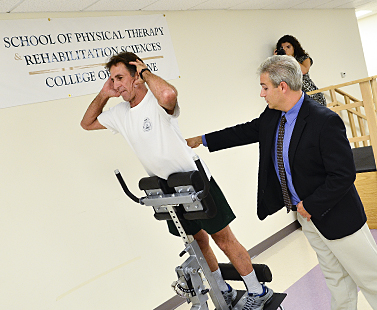
Dr. John Mayer (right), the USF physical therapy & rehabilitation sciences researcher leading the study, explains the back-specific exercise regimen involving a variable-angle roman chair, with the help of Tampa firefighter Karl Wolf.
“Back injuries are the number one cause of permanent disability and early retirement among firefighters,” said John Mayer, DC, PhD, associate professor and Lincoln Endowed Chair in Biomechanical and Chiropractic Research at the USF School of Physical Therapy & Rehabilitation Sciences.
Dr. Mayer was competitively awarded a more than $700,000 grant from the U.S. Federal Emergency Management Agency (FEMA) to test the effectiveness of back-specific exercises in preventing low back injury and pain among firefighters. The protocol for the study was based, in part, on previous FEMA-funded work in which Dr. Mayer and colleagues developed and implemented a wellness and fitness program for the San Diego Fire Rescue Department.
Recognizing that back injuries and associated pain result in lost time and significant medical expenses, FEMA has identified reducing the risk of back injury in firefighters as a priority.
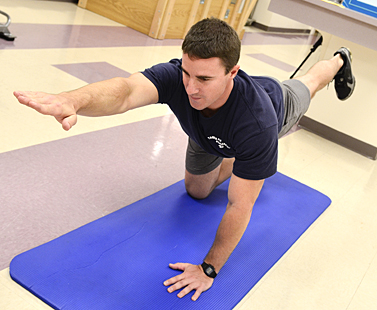
Tampa firefighter Kris Wolf demonstrates the “bird dog,” a core exercise that targets strengthening the lower back.
“This program is a good cooperative effort between Tampa Fire Rescue and USF that I firmly believe can improve the health and fitness of today’s firefighters and tomorrow’s firefighters,” said District Chief Toby Hart of Tampa Fire Rescue, one of the certified peer fitness trainers supervising exercise regimens at the stations. “It has the potential to help the entire firefighting community be more effective.”
The current study has enrolled about 100 active-duty firefighters across 21 Tampa Fire Rescue stations in a twice-a-week workout regimen for six months. The participants were randomized into one of two groups. Half receive supervised exercises targeting their low back in addition to their normal fitness routine. The other half, the control group, continues with their usual fitness routine only.
The back-specific regimen starts with a warm up of low-intensity floor exercises intended to stabilize the core. Then the firefighters move to a specialized machine called a variable-angle roman chair, where they perform high-intensity progressive exercises that target the multifidus, a small but powerful muscle that supports the spine and often is impacted by back injury.

Ultrasound is used by USF researchers to monitor any changes in muscle size that may correlate with improved endurance.
The USF researchers evaluate the firefighters’ progress by observing their strength and endurance during exercises and using ultrasound to look for changes in muscle size. At the end of six months, they’ll compare results of the intervention and control groups to determine if the back-specific exercises made a difference.
Even though final results aren’t expected until next year, Karl Wolf, 55, a firefighter for the last 30 years, notices a difference. He says he can do more sit-ups than before he began the study, his back feels stronger and his core more balanced when he plays recreational hockey. “Anything that may protect my lower back and help me stay in better shape for as long as possible is a plus,” he said.
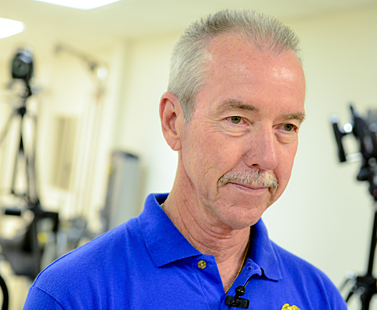
District Chief Toby Hart of Tampa Fire Rescue is a peer fitness trainer who helps supervise the exercise regimen performed by firefighters in the study.
Son Kris Wolf, 30, a firefighter for six years, has seen fellow workers suffer disabling back pain and wants to continue to do all he can to avoid it. “This is a great opportunity to contribute to a university-led, scientific study that may help prolong the careers of firefighters,” he said.
If the study proves the exercise regimen improves back muscle endurance, Dr. Mayer’s next step will be tracking back injury rates in the same population of Tampa firefighters. Ultimately, he hopes to test the protocol with a larger-scale injury prevention trial across several fire service agencies nationwide.
It’s much better to build muscles that can help avoid back stress than to try to treat chronic back injury later, especially with people in strenuous jobs like firefighters and other rescue workers, Dr. Mayer said.
“You want to find an effective exercise intervention that can prevent back injuries …Once the damage is done, it may be too late.”

Fully-outfitted firefighters pack up to 50 pounds in protective gear, including a 35 pound air tank. That extra weight can add to back stress in an already strenuous job.

Father and son firefighters Karl (right) and Kris Wolf say they’ve both noticed differences in how their backs feel since beginning the study.
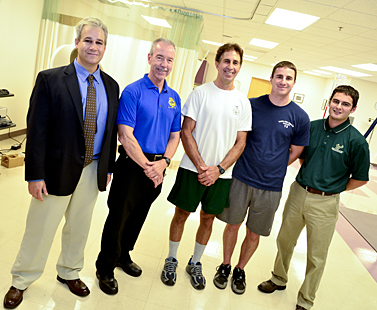
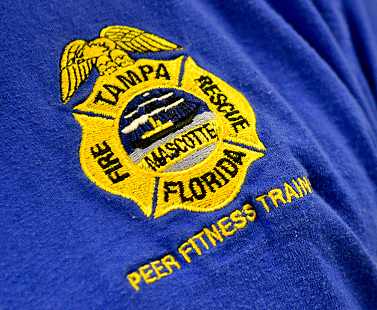
Video by Amy Mariani, story by Anne DeLotto Baier and photos by Eric Younghans, USF Health Communications

